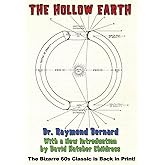
Download the free Kindle app and start reading Kindle books instantly on your smartphone, tablet, or computer - no Kindle device required.
Read instantly on your browser with Kindle for Web.
Using your mobile phone camera - scan the code below and download the Kindle app.

OK
Hollow Earth: The Long and Curious History of Imagining Strange Lands, Fantastical Creatures, Advanced Civilizations, and Marvelous Machines Below the Earth's Surface Hardcover – July 10, 2006
- Print length304 pages
- LanguageEnglish
- PublisherDa Capo Press
- Publication dateJuly 10, 2006
- Dimensions6.75 x 1 x 8.75 inches
- ISBN-100306813734
- ISBN-13978-0306813733
The Amazon Book Review
Book recommendations, author interviews, editors' picks, and more. Read it now.
Similar items that may deliver to you quickly
 The Kingdom of Agarttha: A Journey into the Hollow EarthMarquis Alexandre Saint-Yves d'AlveydrePaperback
The Kingdom of Agarttha: A Journey into the Hollow EarthMarquis Alexandre Saint-Yves d'AlveydrePaperback
Editorial Reviews
From Publishers Weekly
Copyright © Reed Business Information, a division of Reed Elsevier Inc. All rights reserved.
From The New Yorker
Copyright © 2006 Click here to subscribe to The New Yorkeribe to The New Yorker
Review
"A fascinating history of an idea that just refused to die A great read." -- IEEE Spectrum, August 2006
"A monumental work of screwball scholarship A highly entertaining romp." -- Seed Magazine, September 2006
"Fans of Jules Verne will get a thoughtful laugh out of Hollow Earth A thoroughly enjoyable and fascinating read." -- Popular Science, August 2006
"Lively and intriguing." -- Boston Sunday Globe, 9/10/2006
"[A] fascinating account...Standish has done an admirable job...[An] excellent book." -- Scotland on Sunday, 9/3/06
"[A] lively and intriguing illustrated cultural history Highly recommended for both science and literature collections." -- Library Journal, starred review, 7/15/06
"[An] entertaining new book...Standish's research is impressive." -- New York Times Book Review Editor's Choice, 1/28/07
"[Earth] teems with curious tangents...and rewarding artifacts. [It] takes readers deep into a fascinating eddy of history." -- Buffalo News, 9/17/2006
"[The] single strangest and most fascinating book published so far this year...In short, it's a marvel." -- Palm Beach Post, 9/17/2006
About the Author
Product details
- Publisher : Da Capo Press; First Edition (July 10, 2006)
- Language : English
- Hardcover : 304 pages
- ISBN-10 : 0306813734
- ISBN-13 : 978-0306813733
- Item Weight : 1.55 pounds
- Dimensions : 6.75 x 1 x 8.75 inches
- Best Sellers Rank: #1,550,079 in Books (See Top 100 in Books)
- Customer Reviews:
About the author

Discover more of the author’s books, see similar authors, read author blogs and more
Customer reviews
Customer Reviews, including Product Star Ratings help customers to learn more about the product and decide whether it is the right product for them.
To calculate the overall star rating and percentage breakdown by star, we don’t use a simple average. Instead, our system considers things like how recent a review is and if the reviewer bought the item on Amazon. It also analyzed reviews to verify trustworthiness.
Learn more how customers reviews work on Amazon-
Top reviews
Top reviews from the United States
There was a problem filtering reviews right now. Please try again later.
The author is to be commended for going back to original sources where possible, so that the lengthy accounts of the checkered careers of John Symmes and Cyrus Reed Teed given here are about as complete and accurate as you are likely to find. But Teed was no hollow-earth advocate, quite the contrary. His mad genius inverted the cosmos, so that the entire universe was within the earth, with nothing outside. As a result, it is Symmes, not Teed, who so greatly impacted literature and pseudoscience.
Most hollow earth writers, even including Newton collaborator Edmund Halley, seem sublimely ignorant of a fact Newton demonstrated in his work on gravity. Inside a uniform hollow shell, no net gravitational force exists on a test mass placed at any point. Any object inside a hollow planet of uniform thickness would drift at constant velocity until it ran into the shell. If the planet were of non-uniform thickness, the object would accelerate toward the thickest region. So much for suns and moons inside the hollow earth, or sets of concentric shells. Of course we know today from the propagation of compression waves through the earth, pretty much what its internal composition is. Even the huge networks of caves imagined by early writers like Kircher can't exist.
It appears to me that the majority of the hollow-earth enthusiasts around today are Mormons, or have a close Mormon connection. The author doesn't explore this link in any way.
Overall, I found the book disappointing, and fairly tedious in many places. Also, an author with an actual sense of humor could have found considerably more fun in the topic than is excavated here.
However, if you are interested in how the theory of a hollow Earth came about and, most importantly, are interested in how that belief saw itself worked out in literature throughout the ages, then you will enjoy this book very much.
Highly opinionated, snarky, and many times quite amusing, Standish has done his homework (and the bibliography in the back of the book is nothing short of astounding) and he can speak with authority on the subject as he not only reviews the personalities and the history of true believers, but the works of those who chose the theme of the hollow Earth as the focus of their books, novels, films, and philosophies.









